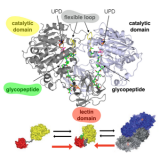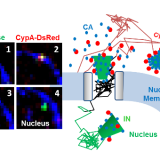Emperador…Orozco {J Chem Theory Comput 11: 5929}

Crystallographic structure (left) and best scored false positive (right) for the complex with PDB code 1GPW. The receptor is colored in dark blue and the ligand in red. The figure on the left shows the position of the ligand (cyan) after the PACSAB simulation. The figure on the right shows snapshots of the ligand during the simulation, in a time-increasing colorscale (from red to blue).
PACSAB: Coarse-Grained Force Field for the Study of Protein-Protein Interactions and Conformational Sampling in Multiprotein Systems
Emperador A, Sfriso P, Villarreal MA, Gelpí JL, Orozco M.
J Chem Theory Comput 2015 Dec; 11:5929. [Epub 20 Nov. 2015]
Molecular dynamics simulations of proteins are usually performed on a single molecule, and coarse-grained protein models are calibrated using single-molecule simulations, therefore ignoring intermolecular interactions. We present here a new coarse-grained force field for the study of many protein systems. The force field, which is implemented in the context of the discrete molecular dynamics algorithm, is able to reproduce the properties of folded and unfolded proteins, in both isolation, complexed forming well-defined quaternary structures, or aggregated, thanks to its proper evaluation of protein-protein interactions. The accuracy and computational efficiency of the method makes it a universal tool for the study of the structure, dynamics, and association/dissociation of proteins.
PubMed: 26597989. Doi: 10.1021/acs.jctc.5b00660


